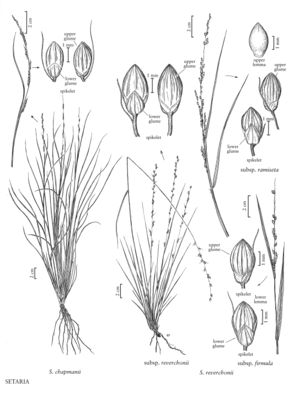Difference between revisions of "Setaria chapmanii"
FNA>Volume Importer |
FNA>Volume Importer |
||
| Line 7: | Line 7: | ||
|synonyms={{Treatment/ID/Synonym | |synonyms={{Treatment/ID/Synonym | ||
|name=Paspalidium chapmanii | |name=Paspalidium chapmanii | ||
| − | |authority= | + | |authority= |
| + | |rank=species | ||
}} | }} | ||
|hierarchy=Poaceae;Poaceae subfam. Panicoideae;Poaceae tribe Paniceae;Setaria;Setaria subg. Paurochaetium;Setaria chapmanii | |hierarchy=Poaceae;Poaceae subfam. Panicoideae;Poaceae tribe Paniceae;Setaria;Setaria subg. Paurochaetium;Setaria chapmanii | ||
| Line 19: | Line 20: | ||
-->{{Treatment/Body | -->{{Treatment/Body | ||
| − | |discussion=<p>Setaria chapmanii is native to soils of coral or shell origin in the Florida Keys, the Bahamas, Cuba, and the Yucatan Peninsula, Mexico. The absence of the lower palea makes S. chapmanii unusual in subg. Paurochaetium.</p> | + | |discussion=<p><i>Setaria chapmanii</i> is native to soils of coral or shell origin in the Florida Keys, the Bahamas, Cuba, and the Yucatan Peninsula, Mexico. The absence of the lower palea makes <i>S. chapmanii</i> unusual in subg. Paurochaetium.</p> |
|tables= | |tables= | ||
|references= | |references= | ||
| Line 28: | Line 29: | ||
-->{{#Taxon: | -->{{#Taxon: | ||
name=Setaria chapmanii | name=Setaria chapmanii | ||
| − | |||
|authority=(Vasey) Pilg. | |authority=(Vasey) Pilg. | ||
|rank=species | |rank=species | ||
| Line 35: | Line 35: | ||
|basionyms= | |basionyms= | ||
|family=Poaceae | |family=Poaceae | ||
| − | |illustrator=Linda A. Vorobik | + | |illustrator=Linda A. Vorobik;Hana Pazdírková |
| + | |illustration copyright=Utah State University | ||
|reference=None | |reference=None | ||
|publication title= | |publication title= | ||
|publication year= | |publication year= | ||
|special status= | |special status= | ||
| − | |source xml=https:// | + | |source xml=https://jpend@bitbucket.org/aafc-mbb/fna-data-curation.git/src/f50eec43f223ca0e34566be0b046453a0960e173/coarse_grained_fna_xml/V25/V25_1394.xml |
|subfamily=Poaceae subfam. Panicoideae | |subfamily=Poaceae subfam. Panicoideae | ||
|tribe=Poaceae tribe Paniceae | |tribe=Poaceae tribe Paniceae | ||
Revision as of 20:33, 16 December 2019
Plants perennial; cespitose. Culms 40-100 cm, erect, slender; nodes glabrous. Sheaths mostly glabrous, margins ciliate distally; ligules 0.1-0.4 mm, of stiff hairs; blades 15-40 cm long, 2-5 mm wide, those of the basal leaves involute, those of the cauline leaves flat, adaxial surfaces sparsely pilose basally. Panicles to 35 cm, nodding, slender, interrupted; rachises scabridulous; branches 5-20, erect, axes 0.4-3.2 cm, undulating, with 3-12 spikelets in 2 ranks, a single bristle present below the terminal spikelets; bristles 3-6 mm. Spikelets 1.8-2.2 mm, obovate, turgid. Lower glumes 0.6-0.8 mm, about 1/3 as long as the spikelets, 3-veined; upper glumes equaling the upper lemmas, 5-7-veined; lower lemmas equaling the upper lemmas; lower paleas absent; upper lemmas finely and transversely rugose; anthers 0.9-1.1 mm. 2n = unknown.
Discussion
Setaria chapmanii is native to soils of coral or shell origin in the Florida Keys, the Bahamas, Cuba, and the Yucatan Peninsula, Mexico. The absence of the lower palea makes S. chapmanii unusual in subg. Paurochaetium.
Selected References
None.
